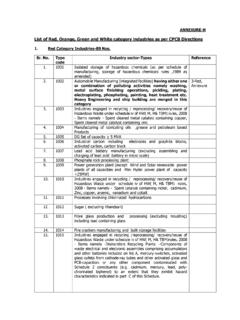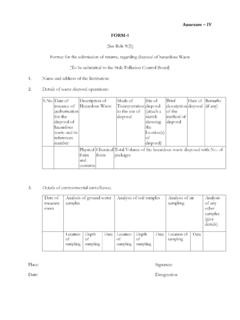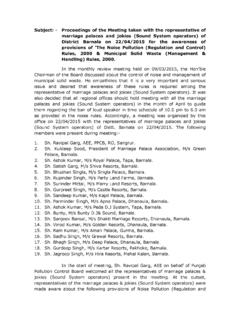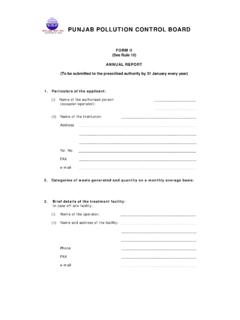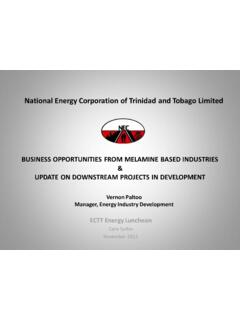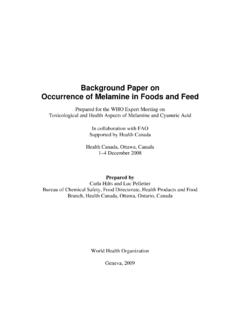Transcription of ANNEXURE -I - PPCB
1 AN N E X U R E-I SCHEDULE 1 LIST OF HAZARDOUS WASTES S. No. Processes Hazardous Wastes 1 2 3 1. Petrochemical processes and pyrolytic operations Furnace/reactor residue and debris* Tarry residues Oily sludge emulsion Organic residues Residues from alkali wash of fuels Still bottoms from distillation process Spent catalyst and molecular sieves Slop oil from wastewater ETP sludge containing hazardous constituents 2. Drilling operation for oil and gas production Drill cuttings containing oil Sludge containing oil Drilling mud and other drilling wastes* 3. Cleaning, emptying and maintenance of petroleum oil storage tanks including ships Oil-containing cargo residue, washing water and sludge Chemical-containing cargo residue and sludge Sludge and filters contaminated with oil Ballast water containing oil from ships.
2 4. Petroleum refining/re-refining of used oil/recycling of waste oil Oily sludge/emulsion Spent catalyst Slop oil Organic residues from process Chemical sludge from waste water treatment Spent clay containing oil 5. Industrial operations using mineral/synthetic oil as lubricant in hydraulic systems or other applications Used/spent oil Wastes/residues containing oil 6. Secondary production and/or use of zinc Sludge and filter press cake arising out of zinc sulphate production Zinc fines/dust/ash/skimmings (dispersible form) Other residues from processing of zinc ash/skimmings Flue gas dust and other particulates* S. No. Processes Hazardous Wastes 1 2 3 7.
3 Primary production of zinc/lead/copper and other non-ferrous metals except aluminium Flue gas dust from roasting* Process residues Arsenic-bearing sludge Metal bearing sludge and residue including jarosite Sludge from ETP and scrubbers 8. Secondary production of copper Spent electrolytic solutions Sludges and filter cakes Flue gas dust and other particulates* 9. Secondary production of lead Lead slag/Lead bearing residues Lead ash/particulate from flue gas 10. Production and/or use of cadmium and arsenic and their compounds Residues containing cadmium and arsenic 11. Production of primary and secondary aluminium Sludges from gas treatment Cathode residues including pot lining wastes Tar containing wastes Flue gas dust and other particulates* Wastes from treatment of salt slags and black drosses* 12.
4 Metal surface treatment, such as etching, staining, polishing, galvanising, cleaning, degreasing, plating, etc.! Acid residues Alkali residues Spent bath/sludge containing sulphide, cyanide and toxic metals Sludge from bath containing organic solvents Phosphate sludge Sludge from staining bath Copper etching residues Plating metal sludge Chemical sludge from waste water treatment 13. Production of iron and steel including other ferrous alloys (electric furnaces; steel rolling and finishing mills; Coke oven and by product plant) Process dust * Sludge from acid recovery unit Benzol acid sludge Decanter tank tar sludge Tar storage tank residue 14.
5 Hardening of steel Cyanide-, nitrate-, or nitrite-containing sludge Spent hardening salt. 15. Production of asbestos or asbestos-containing materials Asbestos-containing residues Discarded asbestos Dust/particulates from exhaust gas treatment. 16. Production of caustic soda and chlorine Mercury bearing sludge Residue/sludges and filter cakes* Brine sludge containing mercury 17. Production of acids Residues, dusts or filter cakes* Spent catalyst* S. No. Processes Hazardous Wastes 1 2 3 18. Production of nitrogenous and complex fertilizers Spent catalyst* Spent carbon* Sludge/residue containing arsenic Chromium sludge from water cooling tower Chemical sludge from waste waster treatment 19.
6 Production of phenol Residue/sludge containing phenol 20. Production and/or industrial use of solvents Contaminated aromatic, aliphatic or napthenic solvents not fit for originally intended use Spent solvents Distillation residues 21. Production and/or industrial use of paints, pigments, lacquers, varnishes, plastics and inks Wastes and residues Fillers residues 22. Production of plastic raw materials Residues of additives used in plastics manufacture like dyestuffs, stabilizers, flame retardants, etc. Residues of platicisers Residues from vinylchloride monomer production Residues from acrylonitrile production Non-polymerised residues 23. Production and/or industrial use of glues, cements, adhesive and resins Wastes/residues (not made with vegetable or animal materials)* 24.
7 Production of canvas and textiles Textile chemical residues* Chemical sludge from waste water treatment 25. Industrial production and formulation of wood preservatives Chemical residues Residues from wood alkali bath 26. Production or industrial use of synthetic dyes, dye-intermediates and pigments Process waste sludge/residues containing acid or other toxic metals or organic complexes Chemical sludge from waste water treatment Dust from air filtration system 27. Production or industrial use of materials made with organo-silicone compounds Silicone-containing residues Silicone oil residues 28. Production/formulation of drugs/ pharmaceuticals Residues and wastes* Spent catalyst / spent carbon Off specification products Date-expired, discarded and off-specification drugs/ medicines Spent mother liquor Spent organic solvents S.
8 No. Processes Hazardous Wastes 1 2 3 29. Production, use and formulation of pesticides including stock-piles Wastes/residues containing pesticides Chemical sludge from waste water treatment Date-expired and off-specification pesticides 30. Leather tanneries Chromium bearing residue and sludge Chemical sludge from waste water treatment 31. Electronic Industry Residues and wastes* Spent etching chemicals and solvents 32. Pulp & Paper Industry Spent chemicals Corrosive wastes arising from use of strong acid and bases Sludge containing adsorbable organic halides 33. Disposal of barrels / containers used for handling of hazardous wastes / chemicals Chemical-containing residue from decontamination and disposal Sludge from treatment of waste water arising out of cleaning / disposal of barrels / containers Discarded containers / barrels / liners used for hazardous wastes/chemicals 34.
9 Purification processes for air and water Flue gas cleaning residue* Toxic metal-containing residue from used-ion exchange material in water purification Chemical sludge from waste water treatment Chemical sludge, oil and grease skimming residues from common industrial effluent treatment plants (CETPs) and industry-specific effluent treatment plants (ETPs) Chromium sludge from cooling water treatment 35. Purification process for organic compounds/solvents Filters and filter material which have organic liquids in them, mineral oil, synthetic oil and organic chlorine compounds Spent catalyst* Spent carbon* 36. Waste treatment processes, incineration, distillation, separation and concentration techniques Sludge from wet scrubbers Ash from incineration of hazardous waste, flue gas cleaning residues Spent acid from batteries Distillation residues from contaminated organic solvents *Unless proved otherwise by the occupier based on sampling and analysis carried out by a laboratory recognized under the Act not to contain any of the constituents mentioned in Schedule 2 to the extent of concentration limits specified therein.
10 SCHEDULE 2 [See rule 3(14)(b)] LIST OF WASTES CONSTITUENTS WITH CONCENTRATION LIMITS* Class A Concentration limit: 50 mg/kg A1 Antimony and antimony compounds A2 Arsenic and arsenic compounds A3 Beryllium and beryllium compounds A4 Cadmium and cadmium compounds A5 Chromium (VI) compounds A6 Mercury and mercury compounds A7 Selenium and selenium compounds A8 Tellurium and tellurium compounds A9 Thallium and thallium compounds A10 Inorganic cyanide compounds A11 Metal carbonyls A12 Napthalene A13 Anthracene A14 Phenanthrene A15 Chrysene, benzo (a) anthracene, fluoranthene, benzo (a) pyrene, benzo (K) fluoranthene, indeno (1, 2, 3-cd) pyrene and benzo (ghi)
